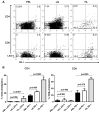Expression profile and in vitro blockade of programmed death-1 in human papillomavirus-negative head and neck squamous cell carcinoma
- PMID: 24710745
- PMCID: PMC4390546
- DOI: 10.1002/hed.23706
Expression profile and in vitro blockade of programmed death-1 in human papillomavirus-negative head and neck squamous cell carcinoma
Abstract
Background: Treatment with a blocking programmed death-1 (αPD-1) antibody recently showed clinical efficacy for various tumor types. In this study, we characterized the expression profile of PD-1/programmed death-ligand-1 (PD-L1) and the potential of PD-1 blockade in human papillomavirus (HPV)-negative head and neck squamous cell carcinoma (HNSCC).
Methods: Lymphocytes from peripheral blood, draining lymph nodes, and the tumor were phenotyped for PD-1 expression, and their proliferative activity was assessed in the presence of blocking αPD-1 treatment. Primary tumor expression of PD-L1 was also analyzed using immunohistochemistry (IHC).
Results: Lymphocyte PD-1 expression was abundant with highest expression in the tumor, and in vitro mixed lymphocyte reaction demonstrated that PD-1 blockade could induce T cell proliferation. Furthermore, tumor cells were found to have 3 distinct patterns of PD-L1 expression with over 78% of the specimens demonstrating strong PD-L1 positivity.
Conclusion: Our data strongly supports the use of αPD-1 blockade in patients with HPV-negative HNSCC that are refractory to standard treatments.
Keywords: T cell; anergy; head and neck squamous cell carcinoma (HNSCC); immunotherapy; programmed death-1 (PD-1).
© 2014 Wiley Periodicals, Inc.
Figures





References
Publication types
MeSH terms
Substances
Grants and funding
LinkOut - more resources
Full Text Sources
Other Literature Sources
Medical
Research Materials

